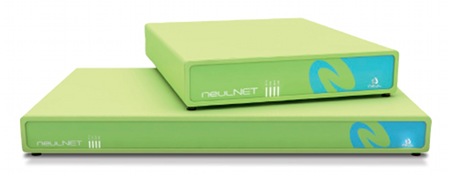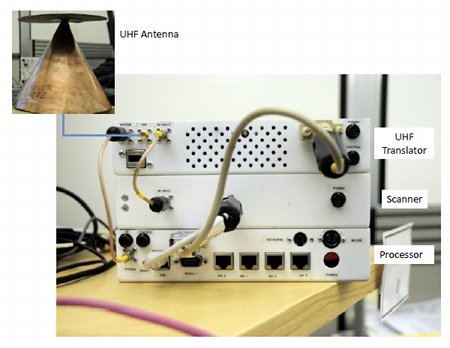White space nets get access devices, pique investor interest
Jun 29, 2011 — by LinuxDevices Staff — from the LinuxDevices Archive — 5 viewsWhite space networking received a vote of confidence June 29 in the form of a $12.8 million investment in Cambridge, U.K.-based Neul. The company — which is participating with Microsoft and others in ongoing tests — also announced “NeulNET,” said to be the world's first production white space radio system.
We reported earlier this week that Neul (it rhymes with "fuel") is one of the partners in the new Cambridge TV White Spaces Consortium, whose other members include the BBC, BSkyB, BT, Cambridge Consultants, Microsoft, Nokia, Samsung, Spectrum Bridge Inc. and TTP. The group will exploit a special multi-site license from U.K. regulator Ofcom to test white space (a.k.a. "WhiteFi") hotspots at local pubs, other leisure venues, and commercial and residential premises, Microsoft announced.
According to Microsoft, the white space testing will involve streaming video and audio content from the BBC and BSkyB "to a range of mobile devices, including some from Nokia and Samsung."
As far as we're aware, however, there are no relevant chipsets that actually fit inside phones. It appears mobile testing will initially take place via relatively large equipment wired to notebook computers.
While Silicon Valley startup Adaptrum has demonstrated relevant prototypes — and was mentioned in a June 27 blog posting about the tests by a Microsoft vice president — Cambridge's own Neul has created devices that could also be employed. In fact, the company claims its "NeulNET" system (below) is the world's first production WhiteFi System.

The NeulNET devices
(Click to enlarge)
The NeulNET products include a basestation, equipped with a GPS receiver for accurate positioning, plus a 9 x 7.1 x 1.6-inch terminal, the latter battery-operable. Both devices are equipped with Ethernet ports, for connection to a Wi-Fi access point on the one hand and a notebook computer (or other client) on the other.
According to Neul, these devices are suitable for M2M applications, with data rates from 2kbps to 2Mbps, or for rural broadband, with speeds up to 16Mbps. The company says the open "Weightless" standard employed uses time division multiple access (TDMA) to divide up the available capacity on the downlink, and a combination of TDMA and frequency division multiple access (FDMA) on the uplink, allowing "up to one million terminals per basestation."
Neul didn't specify how its devices link into databases listing incumbent users of white space frequencies (see later in this story), but says NeulNET is compatible with US, European, and Japanese TV channel assignments and can eliminate interference to wireless microphones. A proprietary technology cancels signals from distant TV transmitters, the company adds.
Meanwhile, Neul said on June 29 that it has raised $12.8 million (about $6 million) from a syndicate of investors led by European venture capital firm DFJ Esprit and including IQ Capital and Cambridge Angels. Its founders and employees have also made a "significant contribution," the company added.
Neul was formed in 2010 by some of the founders of Cambridge Silicon Radio, which pioneered the development of single-chip Bluetooth transceivers in CMOS. Simon Cook, CEO of DFJ Esprit, stated, "Having worked with the founders in their last venture, I am excited to be working again with the team that has pioneered game-changing wireless technology in Europe."
Background
White space networking will rely on radio spectrum that was previously reserved for TV stations. Because available frequencies vary from location to location, the technology will require access points and clients fitted with cognitive radio equipment, which can detect interference and automatically switch frequencies when they need to.
At the end of 2008, the FCC issued a ruling permitting the use of unlicensed devices in the "white spaces" vacated when analog television signals were switched off. The catch is, any new users are not allowed to interfere with any licensed incumbents, which include not only TV stations but also older wireless microphones.
Last November, therefore, the FCC approved the concept of databases that would identify incumbent users, including full- and low-power stations, that are entitled to interference protection. The databases, which will be privately owned and operated services, would tell white space devices which TV channels are vacant and may be used at their location.
Subsequently, as we reported in January, Google asked to become one of the white space database administrators. Its proposal to the FCC said it would "cooperate … to develop a process for databases to provide to one another, on a daily basis, information about registered cable TV headends, TV translator station receive sites, operating sites of wireless microphones and other low power auxiliary stations, and fixed white space devices."
Unfortunately, however, "there exists no infrastructure today for measuring real-time spectrum occupancy across vast geographical regions," according to a paper presented in March at the USENIX Symposium on Networked Systems Design and Implementation in Cambridge, Mass. According to six researchers — one from the Indian Institute of Science and five from Microsoft Research India — white spaces are heavily under-utilized as a result.
The spectrum analyzers necessary to measure when and where frequencies are available cost from $10,000 to $40,000 apiece. Given that this is such a major hurdle, the paper, "SpecNet: Spectrum Sensing Sans Frontires," proposed a cooperative network that would be used to connect multiple analyzers over a wide area.

Microsoft's 2009 WhiteFi prototype
(Click to enlarge)
In 2009, meanwhile, Microsoft received an experimental license from the Federal Communications Commission allowing it to build a prototype, "campus wide" WhiteFi system on the company's Redmond campus. Nicknamed KNOWS, the device (above) included a PC, a scanner, a standard WiFi card, and a UHF translator that converts incoming and outgoing 2.4GHz signals to the 512 to 698MHz band.
The scanner in the KNOWS device used SIFT (Signal Interpretation before Fourier Transform) techniques to detect the presence of TV broadcasts and wireless microphone signals, even when they are intermittent and received over multiple channel widths. WhiteFi provides a "chirping" protocol that lets clients signal when they are disconnected due to a channel conflict, without interfering with a wireless microphone or other primary user, the company added at the time.
Further information
More information about the Neul devices may be found on the NeulNET product page.
Jonathan Angel can be reached at [email protected] and followed at www.twitter.com/gadgetsense.
This article was originally published on LinuxDevices.com and has been donated to the open source community by QuinStreet Inc. Please visit LinuxToday.com for up-to-date news and articles about Linux and open source.